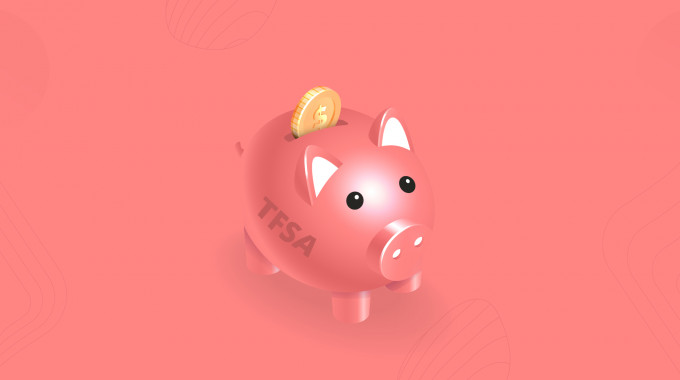Many Canadians don’t know how TFSAs work, when or why they should contribute to one, and how they compare against RRSPs, regular savings accounts, or other investment products.
If you consider yourself TFSA-confused, take a few minutes to bring yourself up to speed with this quick overview. Under the right circumstances, contributing to a TFSA is a key piece of any sound financial strategy. But to get the most out of them, you first need to know how they work and what their limitations are.
How Does A TFSA Work
TFSAs were introduced in 2009 by the Canadian government to encourage Canadians to save more money. Unfortunately, the name “Tax-Free Savings Account” is a little misleading and may explain some of the lingering confusion. TFSAs are neither fully tax-free nor fully savings accounts.
At its most basic level, a TFSA is a bank account where you can deposit your money, and any interest you earn on that money is tax-free. For example, if you invest $5,000 into your TFSA and a few years later with interest, it’s grown to $6,000, you’ll pay zero taxes on the extra $1,000 when you withdraw it.
This is the key difference between RRSPs and TFSAs. Unlike RRSP contributions, which lower your taxable income, you still pay taxes on the money you deposit into your TFSA. You only save taxes on earned interest on eligible investments. However, TFSAs offer a flexible way to save while still having access to your money.
What You Need To Open A TFSA
In order to open a TFSA in Canada, you need to be at least 18 years of age and have a valid SIN number. This means that you don’t have to be a Canadian resident to open one. You can also be a temporary resident.
Are TFSAs Better Than Savings Account
Despite its name, a Tax-Free Savings Account isn’t strictly limited to being a savings account at all. It’s kind of like a personal investing account that can also be used to buy GICs, mutual funds, stocks, and ETFs. All of the earned interest, dividends, and returns from these remain tax-free.
Of course, you can also choose to use your TFSA as a simple savings account as well. The choice is yours, and this flexibility is what separates a TFSA from a standard savings account. Before you make that choice, however, take some time to assess your financial situation and understand whether you should be saving or investing.
Using a TFSA to invest in things like mutual funds and ETFs will generally lead to greater compound-interest gains than sticking with simple savings account interest. However, if you’re a new investor, you’ll want to educate yourself on how to invest safely and strategically before using TFSAs to invest in more advanced financial products.
Amount That Can Go Into A TFSA
One thing TFSAs have in common with RRSPs is they also have yearly contribution limits. Unlike RRSPs though, TFSA limits aren’t tied to your income. They’re set each year by the government and unused amounts roll over from year to year to a lifetime limit that’s also updated yearly.
TFSA Limit In 2025
For 2025, the TFSA contribution limit is $7,000, and the lifetime limit for rolled-over amounts (also known as your TFSA contribution room) is $102,000. The amount applies if you were 18 years old in 2009. That is when your available contribution room starts. The Canada Revenue Agency (CRA) tracks your contribution room for you, so if you’re not sure what yours is at the moment, you can find out online or over the phone.
Pay close attention to your contributions. There’s a steep penalty for contributing over your limit. Even if you over-contributed accidentally, you’ll be dinged a 1% penalty on your excess amounts every month until you withdraw it.
Taking Money Out Of Your TFSA
One of the main advantages of a TFSA is that you can withdraw your money at any time without penalty. Unlike RRSP savings, you’ve already paid taxes on your TFSA amounts so the money is yours to withdraw (although depending on your financial institution, you may incur a small transactional fee).
However, if you do withdraw money from your TFSA you can’t put it back right away. You’ll need to wait until the following year to gain that contribution room back.
Maximizing Your TFSA
TFSAs are a great tool anyone can use to build their savings but if you’re not using them properly you might be leaving money on the table. Follow these simple rules to maximize your TFSA.
1. Start With The Right Savings Goals
To get the most out of TFSAs, you need to understand your financial goals. If your goal is to save for your retirement, RRSPs may be a better option to start with. However, if you’re already annually maxing out your RRSP contributions, then contributing to a TFSA is a logical next step.
If your goal is to save for a large financial purchase, TFSAs are ideal because you can withdraw them anytime without penalty (unlike RRSPs).
2. Choose The Right Account
Depending on your savings goals, spend some time exploring the different options available to you for opening a TFSA. You can open one (or several) through your bank and use it as a simple savings account, or you can open one for through a service like Wealthsimple or Questrade for investing in financial products like stocks, mutual funds, and ETFs.
3. Choose The Right Products
There’s no right answer for how you should use your TFSA. If you want to maximize your gains through interest and dividends, you’ll need to invest your TFSA dollars in high-growth vehicles like mutual funds, stocks, bonds, and ETFs. Before you dive right in, make sure you educate yourself on how to start investing, and whether you should be saving or investing.
4. Maximize Your Contribution Room
Getting the most out of your TFSA typically means maxing out your contribution limit year over year. This isn’t always possible, but if you have the means, doing this will maximize the tax-free gains you can earn each year. Over the course of several years or even decades, this will add up to meaningful amounts that can be reinvested again and again.
5. Automate Monthly Contributions
Few people have several thousand dollars lying around waiting to be plunked into a TFSA once or twice a year. If you rely on dumping large chunks of extra cash into your account in order to grow your TFSA, chances are you’ll always find other ways to spend the extra money.
Instead, set up reasonable automatic monthly or bi-weekly contributions to your TFSA. You can schedule these automatic contributions to coincide with your paychecks and only contribute a set amount you’re comfortable putting aside for your savings goals.
Alternative’s To TFSA’s
Depending on what you’re investing for and when you want to use your funds, it may be a good option to choose a TFSA alternative or use an alternative account at the same time. There are two main alternatives to TFSAs. These are High-Interest Savings Accounts and Registered Retirement Savings Plans.
High-Interest Savings Accounts
High-Interest Savings Accounts, also known as HISAs, are non-registered accounts with higher interest rates that you don’t invest in. If you’re just looking to save your money, then these are the types of accounts that you want to use. Depending on the bank you choose, these accounts can also have low fees and earn cash back. That said, you don’t earn capital gains on this money, but it’s a good way to accumulate an emergency fund.
Registered Retirement Savings Plans
If you’re looking for another registered savings account and want to save for retirement, then this is the account for you. With this account, you can also earn investment income through qualified investments. However, RRSPs are a bit different than TFSAs in the sense that their contributions are tax-deductible. This is because the tax on RRSPs is deferred and only paid when you withdraw the funds. The taxes you pay when you withdraw the funds are based on the income earned throughout the year.
That said, just like TFSAs, RRSPs also have contribution limits. There will be a penalty if you go over these limits. There’s also a penalty if you withdraw the funds from an RRSP early. This penalty is referred to as a withholding tax and is charged at a rate that is based on how much you withdraw. For amounts $5,000 and under, the rate is 10%; for amounts between $5,000 and $15,000, the rate is 20%; and for amounts above $15,000, the rate is 30%.
First Home Savings Accounts
Another registered savings account that you can use to save your money is a First Home Savings Account, also known as a FHSA. This account is used to save funds for your first home with added benefits. You can invest in it to save funds, and all of the contributions are tax deductible. This means as long as the funds are used to purchase a home, you don’t need to pay any taxes.
That said, FHSAs do have time restrictions and annual limits that you have to stay within. First, you can only put up to $8,000 per year in your FHSA. However, the lifetime limit is $40,000. Once you’ve had the account for 15 years, though, you either need to use it or transfer it into a different account.
What To Do In The Event Of A TFSA Over Contributions
As we mentioned, there are limits you have to stay within when adding funds to your TFSA. If you do go over these limits, then there are penalties that you will have to pay. This penalty is 1% of the highest excess TFSA amount. It’s best to remove those funds as soon as possible in order to reduce the penalty. However, there’s also another alternative to consider, which is an unused contribution room.
How Unused Contribution Room Works
How much contribution room you have in your TFSA is based on your yearly limit as well as your annual contribution limit. If you don’t reach either of these limits, then the unused contribution amounts are carried forward to the next calendar year. Unlike RRSPs, TFSAs work with a calendar year and not a tax year.
That said, it’s important to keep the TFSA rules in mind when you withdraw funds from your TFSA. The contribution room isn’t updated until the next year, so if you re-contribute right away, then you could end up paying over-contribution penalties. This can get confusing when figuring out your limits if you’re taking funds out for subsequent years. A TFSA calculator or speaking with an advisor can get you the accurate information for current and previous years as well as provide investment advice you need to help you get the correct amounts for tax treatment.
Related articles
How RRSPs Work: Everything Beginners Need To Know
Is It Better to Invest in RRSP or TFSA?
5 Simple Rules For Getting Started As A New Investor








